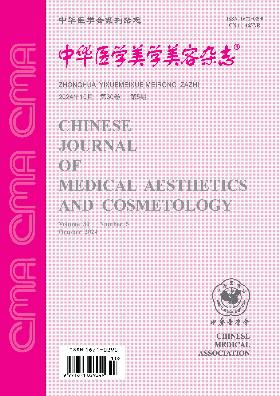Cognitive status of Chinese acne patients and its influencing factors
引用次数: 0
Abstract
Objective To indentify the cognitive status of Chinese patients to acne and the influencing factors to theirs' cognitive status, so as to provide solid evidences for the prevention and treatment of acne. Methods A self-designed questionnaire was made to conduct this survey of 16, 156 acne patients, who seeked to the treatment in the dermatological departments from 112 hospitals in China. The survey consisted of several parts, including the general status of patients, the patients' cognition of occurrence, development and risk factors of acne, whether the first choice was seeking treatment at the hospital when the patients had acne and the condition of selection of skin care products. The factors were analyzed, which could impact the cognition of the patients' behavior of treatment, how did the patients' cognition to influence their medical behavior and skin care as well as the consistency of assessment of the severity of acne by doctors and patients themselves. Results The acne patients studied had the best knowledge of " acne is a skin disease" , " it not only occurs in the period of adolescence" and " the disease can be prevented and cured" , which accordingly accounted for 80.65%, 69.16% and 65.49% of the total patients respectively. However, the awareness of acne patients to heredity, high sugar and dairy products as risk factors for acne was insufficient, which accounted for 48.72%, 42.40% and 18.25% of the total patients, respectively. Gender, age, educational level, occupation and health knowledge were the main factors affecting the cognitive level of patients; the survey also found that men, patient with educational level of junior high or even lower educational condition, occupation of labor workers or farmers and patients were lack of health education with poor knowledge of the genetics and dietary were risk factors for acne; patients with age over 36 years or with mild illness had poor knowledge of dietary risk factors for acne; the difference was statistically significant (P<0.05). The analysis of the influence of cognitive status on medical treatment behavior and skin care showed that the better the cognition, the higher the probability of patients would choose medical treatment as the first choice as well as choosing functional skin care products; the difference was statistically significant (P<0.05). The consistency of assessment of the severity of acne by doctors and patients was poor (Kappa value <0.4), and the assessment of severity of acne by patients was more serious than doctors' assessment. Conclusions Patient's cognitive status will affect their medical behavior and skin care, and there is also a phenomenon that patients have a more serious assessment of their acne condition. It is suggested that health education for acne patients should be strengthened in clinical medicine so as to improve their knowledge of acne as well as preventing from acne effectively. Key words: Acne vulgaris; Questionnaires; Cognition; Epidemiology; Influencing factors中国痤疮患者的认知状况及其影响因素
目的了解我国痤疮患者的认知状况及影响其认知状况的因素,为痤疮的防治提供依据。方法采用自行设计的问卷,对全国112家医院皮肤科就诊的16156例痤疮患者进行调查。调查内容包括患者一般情况、患者对痤疮发生、发展及危险因素的认知情况、患者出现痤疮时是否首选到医院就诊、选择护肤品的情况等几个部分。分析影响患者治疗行为认知的因素,患者认知如何影响其医疗行为和皮肤护理,以及医生和患者对痤疮严重程度评估的一致性。结果受访痤疮患者对“痤疮是一种皮肤病”、“痤疮不仅发生在青春期”和“痤疮是可以预防和治愈的”的认知程度最高,分别占总人数的80.65%、69.16%和65.49%。然而,痤疮患者对遗传、高糖和乳制品作为痤疮危险因素的认识不足,分别占总患者的48.72%、42.40%和18.25%。性别、年龄、文化程度、职业、健康知识是影响患者认知水平的主要因素;男性、文化程度为初中及以下的患者、职业为劳动工人或农民、缺乏健康教育、遗传和饮食知识贫乏的患者是发生痤疮的危险因素;年龄在36岁以上或病情较轻的患者对痤疮的饮食危险因素认识不足;差异有统计学意义(P<0.05)。认知状况对就医行为和护肤的影响分析表明,认知状况越好,患者选择就医为第一选择的概率越高,选择功能性护肤品的概率越高;差异有统计学意义(P<0.05)。医患对痤疮严重程度的评价一致性较差(Kappa值<0.4),患者对痤疮严重程度的评价比医生的评价更严重。结论患者的认知状态会影响其就医行为和皮肤护理,患者对自身痤疮状况的评价也较为严重。建议在临床医学中加强对痤疮患者的健康教育,提高患者对痤疮的认识,有效预防痤疮。关键词:寻常痤疮;问卷调查;认知;流行病学;影响因素
本文章由计算机程序翻译,如有差异,请以英文原文为准。
求助全文
约1分钟内获得全文
求助全文
来源期刊
自引率
0.00%
发文量
4641
期刊介绍:
"Chinese Journal of Medical Aesthetics and Cosmetology" is a high-end academic journal focusing on the basic theoretical research and clinical application of medical aesthetics and cosmetology. In March 2002, it was included in the statistical source journals of Chinese scientific and technological papers of the Ministry of Science and Technology, and has been included in the full-text retrieval system of "China Journal Network", "Chinese Academic Journals (CD-ROM Edition)" and "China Academic Journals Comprehensive Evaluation Database". Publishes research and applications in cosmetic surgery, cosmetic dermatology, cosmetic dentistry, cosmetic internal medicine, physical cosmetology, drug cosmetology, traditional Chinese medicine cosmetology and beauty care. Columns include: clinical treatises, experimental research, medical aesthetics, experience summaries, case reports, technological innovations, reviews, lectures, etc.

 求助内容:
求助内容: 应助结果提醒方式:
应助结果提醒方式:


